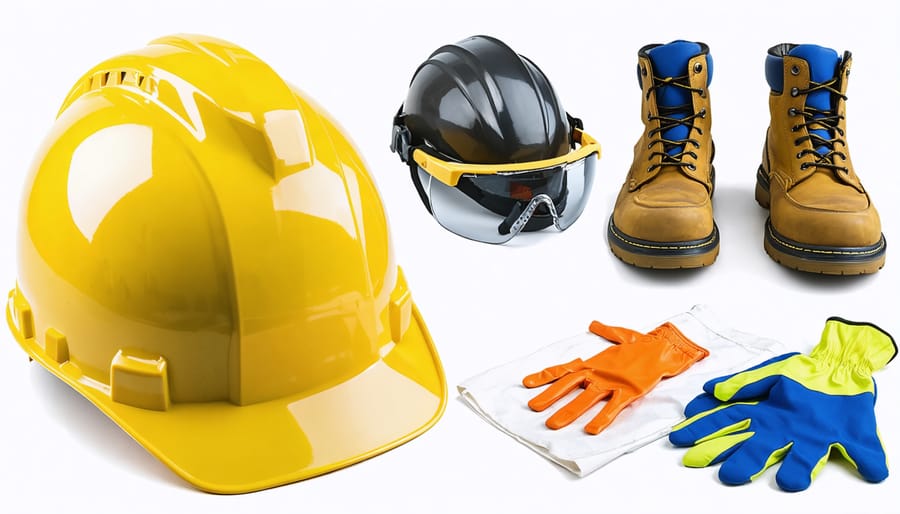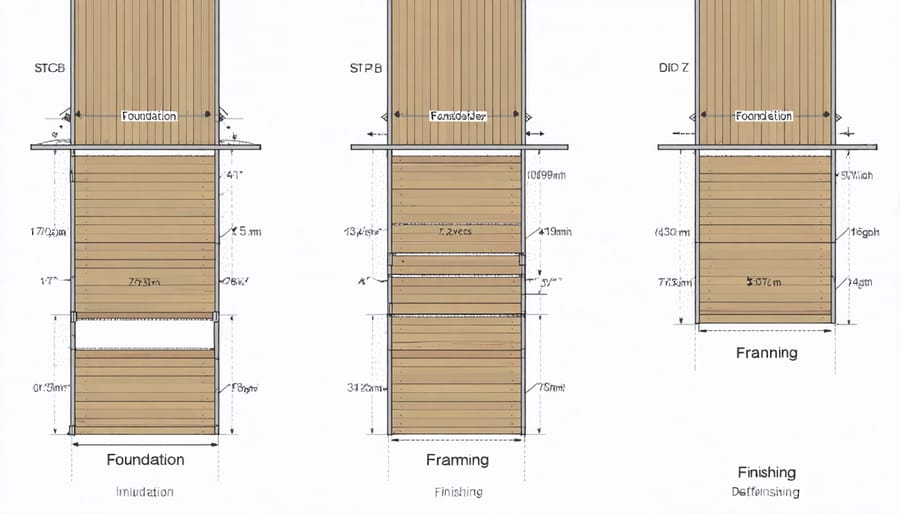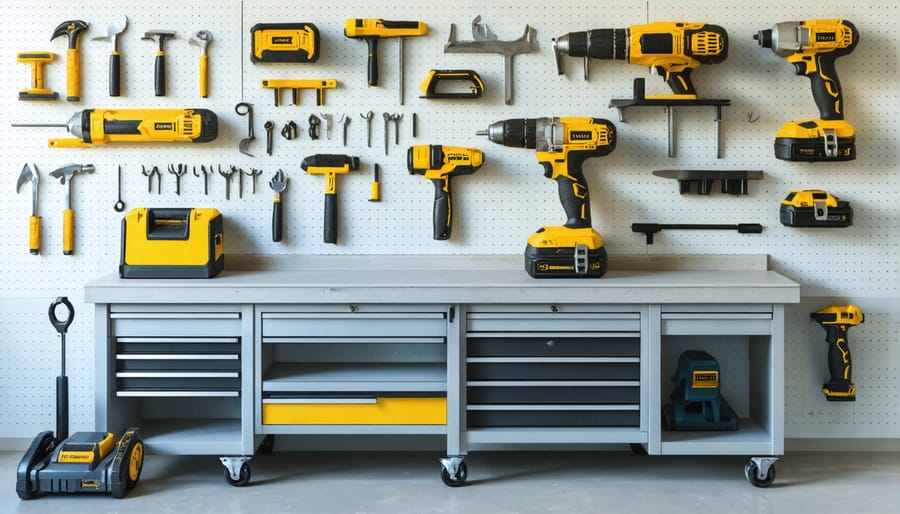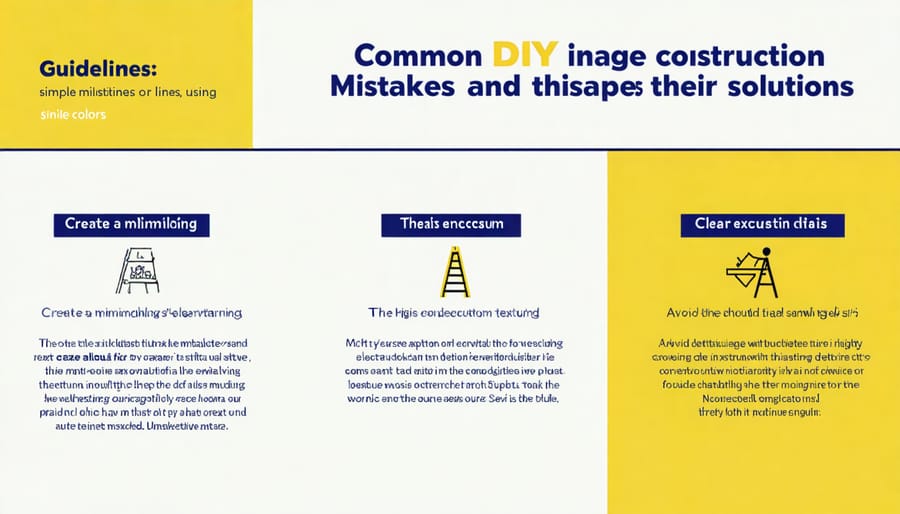Transform your home through strategic DIY construction projects by mastering fundamental building principles and industry-tested methodologies. Professional-grade results demand meticulous planning, comprehensive safety protocols, and precise execution—skills that separate successful home builders from novices attempting basic repairs.
Start with easy construction projects to build essential competencies while minimizing risk. Analyze structural requirements, obtain necessary permits, and invest in commercial-grade tools before breaking ground. Professional contractors routinely emphasize proper material selection and adherence to local building codes as cornerstones of successful DIY construction.
Modern construction techniques, when properly implemented by informed homeowners, can deliver results comparable to professional installations at a fraction of the cost. Essential prerequisites include understanding load-bearing calculations, mastering proper tool operation, and developing a comprehensive project timeline with clear milestones. This methodical approach ensures safety compliance while maximizing resource efficiency—critical factors that influence project success rates among DIY enthusiasts tackling home construction ventures.
[Word count: 248]
Essential Planning and Safety Considerations
Permits and Regulations
Before commencing any DIY home construction project, obtaining the proper permits and understanding local building codes is essential for legal compliance and project success. Most jurisdictions require permits for structural modifications, electrical work, plumbing installations, and significant renovations. Contact your local building department early in the planning phase to determine specific requirements for your project.
Common permits include building permits, electrical permits, plumbing permits, and mechanical permits. The application process typically involves submitting detailed plans, paying fees, and scheduling inspections at various construction phases. Be prepared to provide documentation including property surveys, architectural drawings, and structural calculations when applicable.
Building codes vary by location but generally address safety standards, structural integrity, fire protection, and energy efficiency. Key areas of regulation include foundation requirements, load-bearing capacities, electrical circuit specifications, plumbing systems, and ventilation standards. Non-compliance can result in substantial fines, project delays, or mandatory demolition.
For DIY builders, working with a licensed inspector throughout the construction process can prevent costly mistakes and ensure code compliance. Many jurisdictions require certified professionals for specific tasks like electrical work or gas line installations, even in DIY projects. Maintain detailed records of all permits, inspections, and modifications to protect your investment and facilitate future property transactions.
Safety Equipment and Protocols
Personal protective equipment (PPE) forms the foundation of safe DIY construction practices. Essential safety gear includes a properly fitted hard hat rated to ANSI Z89.1 standards, impact-resistant safety glasses with side shields, and steel-toed boots meeting ASTM F2413-18 requirements. Respiratory protection, such as N95 masks for dust and appropriate cartridge respirators for chemical exposure, is crucial when handling hazardous materials.
Work gloves should be task-specific: leather for general construction, cut-resistant for sharp materials, and chemical-resistant when working with concrete or solvents. Hearing protection with a minimum Noise Reduction Rating (NRR) of 25 decibels is mandatory when operating power tools.
Essential safety protocols include establishing a designated work zone with proper signage and barriers. Maintain a clean workspace by removing debris regularly and securing tools when not in use. Before starting any project, conduct a thorough risk assessment and ensure all power tools have functioning safety guards and emergency shut-off mechanisms.
Always work with a partner when handling heavy materials or working at heights. Use OSHA-compliant fall protection systems for any work above 6 feet, including properly secured scaffolding and personal fall arrest systems. Keep a fully stocked first aid kit and working fire extinguisher readily accessible, and maintain emergency contact information prominently displayed in the work area.

Cost-Effective DIY Construction Projects
Room Additions
Room additions require meticulous planning and execution to ensure structural integrity and compliance with local building codes. Begin by assessing your property’s foundation capabilities and zoning restrictions. Create detailed architectural drawings that include electrical, plumbing, and HVAC considerations while incorporating energy-efficient construction methods into your design.
Start with foundation work, ensuring proper soil preparation and reinforcement. Pour concrete footings according to engineering specifications, typically extending below the frost line. Install anchor bolts for wall attachment and allow sufficient curing time before proceeding.
Frame the walls using appropriate dimensional lumber, typically 2×4 or 2×6 studs at 16-inch centers. Install double top plates and ensure proper header sizing above windows and doors. Integrate the new roof structure with existing rooflines, paying careful attention to valley intersections and proper flashing installation.
Connect the addition to the existing structure by creating a proper tie-in point. Remove exterior siding or brick veneer as needed, and install appropriate flashing and weatherproofing materials. Ensure continuous vapor barriers and proper insulation installation between old and new sections.
Rough-in electrical, plumbing, and HVAC systems before installing drywall. Schedule required inspections at each phase: foundation, framing, mechanical systems, and final completion. Address any code compliance issues immediately to avoid costly corrections later.
Complete interior finishes to match existing home aesthetics, ensuring seamless integration between old and new spaces. Pay particular attention to floor transitions and ceiling height alignments for professional results.

Deck Construction
Constructing a deck requires careful planning and precise execution to ensure both safety and longevity. Begin by selecting appropriate materials based on your climate and budget. Pressure-treated lumber remains the most common choice due to its durability and cost-effectiveness, while composite decking offers enhanced weather resistance and minimal maintenance requirements.
The foundation starts with proper footings, typically concrete piers that extend below the frost line. Space these according to your local building codes, usually 6-8 feet apart. Install support posts using post anchors or direct burial methods, ensuring they’re perfectly plumb using a level.
For the structural framework, use appropriately sized joists and beams based on span tables. A typical residential deck requires 2×8 or 2×10 joists spaced 16 inches on center. Install joist hangers and blocking to prevent twisting and provide additional stability. The ledger board, which connects the deck to the house, must be properly flashed and secured with lag screws or through-bolts to prevent water infiltration and ensure structural integrity.
When laying decking boards, maintain consistent spacing (usually 1/8 inch) for proper drainage and ventilation. Use hidden fasteners or deck screws, never nails, to secure boards. Consider incorporating features like diagonal decking patterns or picture framing for enhanced aesthetic appeal while maintaining structural integrity.
Always obtain necessary permits and adhere to local building codes, particularly regarding railing height requirements and balusters spacing. Professional inspection at key construction phases ensures compliance and safety. Regular maintenance, including annual cleaning and sealing, will extend your deck’s lifespan significantly.
Garage Conversions
Converting a garage into living space represents one of the more complex DIY structural projects, requiring careful planning and adherence to local building codes. Begin by assessing the existing structure, focusing on foundation integrity, wall insulation requirements, and electrical capacity. The conversion process typically involves several key phases:
First, evaluate and upgrade the electrical system to accommodate increased demand, ensuring compliance with residential codes. Install additional circuits and outlets according to local regulations, considering the intended use of the space. Address HVAC requirements by extending existing ductwork or installing a separate climate control system.
Insulation plays a crucial role in creating a comfortable living environment. Install proper wall and ceiling insulation to meet R-value requirements for living spaces. Consider installing a vapor barrier to prevent moisture issues, particularly in areas with high humidity levels.
The garage door opening requires special attention. Remove the existing door and frame in the opening with appropriate load-bearing materials. Install proper headers and construct an insulated wall with windows or doors as desired. Ensure the new wall matches both interior and exterior aesthetics.
Flooring modifications are essential, as garage floors typically slope for drainage. Level the surface using self-leveling compound or by installing a subfloor system. Address moisture concerns by applying appropriate sealants and installing proper drainage solutions where necessary.
Finish the space by installing drywall, adding appropriate lighting fixtures, and completing interior finishes. Pay particular attention to proper ventilation and ensure all work meets fire safety requirements, including proper fire-rated materials and emergency egress windows if required by code.
Throughout the project, maintain detailed documentation and obtain necessary permits. Consider consulting with structural engineers for load-bearing modifications and licensed electricians for complex electrical work to ensure safety and code compliance.
Tools and Materials
Must-Have Equipment
A well-equipped toolset forms the foundation of successful DIY construction projects. Essential power tools include a cordless drill/driver with various bits, a circular saw for precise cuts, and a reciprocating saw for demolition work. A quality table saw proves invaluable for larger projects requiring numerous straight cuts.
Hand tools remain equally crucial, starting with a comprehensive measuring and marking kit: tape measure, speed square, level, and chalk line. A professional-grade hammer, multiple screwdrivers, and adjustable wrenches are fundamental. Include both flathead and Phillips head screwdrivers in various sizes for versatility.
Safety equipment is non-negotiable: invest in ANSI-approved safety glasses, hearing protection, respirators, and work gloves. A proper tool belt helps maintain efficiency and workplace organization.
For concrete work, acquire a mixing paddle, wheelbarrow, and various trowels. Woodworking tasks demand quality chisels, planes, and clamps. Consider renting larger equipment like concrete mixers or air compressors for specific projects rather than purchasing.
Storage solutions are essential – invest in a robust toolbox or rolling cabinet to protect and organize your equipment. Remember to maintain your tools regularly, keeping them clean and properly stored to ensure longevity and optimal performance. Quality tools, while initially more expensive, provide better results and superior durability for long-term value.

Material Selection Guide
Selecting appropriate materials for your DIY home construction project requires careful consideration of multiple factors. Begin by evaluating the structural requirements, local building codes, and climate conditions specific to your area. For foundation work, choose between ready-mix concrete or concrete blocks based on your project scope and expertise level.
When it comes to framing, pressure-treated lumber is essential for ground contact areas, while standard dimensional lumber works well for above-ground applications. Consider engineered wood products like LVL beams or I-joists for enhanced structural stability in load-bearing applications.
For exterior applications, focus on weather-resistant materials such as fiber cement siding, quality roofing shingles, or metal roofing systems. Interior materials should balance durability with aesthetic appeal – moisture-resistant drywall for bathrooms, standard drywall for living spaces, and appropriate insulation materials based on your climate zone.
Success in cost-effective material sourcing often depends on timing your purchases and understanding market fluctuations. Consider factors like material grade, warranty coverage, and long-term maintenance requirements. For sustainable construction, explore eco-friendly alternatives such as recycled materials or locally sourced products that meet building code requirements while reducing environmental impact.
Always verify material compatibility and proper installation requirements before making final selections. Consult manufacturer specifications and local building authorities when uncertain about material choices.
Professional Tips and Common Pitfalls

Expert Insights
Leading construction professionals emphasize that successful DIY home improvement projects begin with meticulous planning and adherence to fundamental principles. Mark Thompson, a 25-year veteran contractor, advises maintaining a comprehensive project documentation system, including detailed material lists, timeline projections, and daily progress logs.
Safety consultant Sarah Martinez emphasizes the critical importance of proper personal protective equipment (PPE) and recommends investing in professional-grade tools rather than budget alternatives for long-term cost efficiency. “Quality tools not only ensure precision but also significantly reduce accident risks,” Martinez explains.
Master builder James Chen highlights the value of moisture management in structural integrity. “Always work from the bottom up and ensure proper drainage systems are in place before proceeding with any structural modifications,” he advises. Chen also recommends conducting thorough site surveys and soil tests before breaking ground on any foundation work.
Architectural specialist Lisa Rodriguez stresses the importance of understanding local building codes and obtaining necessary permits. “Many DIY enthusiasts overlook zoning requirements, which can lead to costly corrections later,” she notes. Rodriguez suggests consulting with local authorities and possibly hiring a professional inspector for critical project phases to ensure compliance and structural integrity.
When to Call the Pros
While DIY construction projects can be rewarding, certain situations demand professional intervention to ensure safety, compliance, and structural integrity. Professional contractors should be engaged when projects involve electrical systems, particularly when modifying circuits or installing new power sources. Plumbing modifications that affect main supply lines or sewage systems also require licensed professionals to prevent costly water damage and ensure code compliance.
Structural modifications, including load-bearing wall removal, foundation work, or major roof alterations, necessitate engineering expertise and proper permits. Complex HVAC installations or modifications should be handled by certified technicians to maintain system efficiency and prevent potential hazards.
Projects requiring specialized permits or those affecting multiple building systems typically need professional oversight. Additionally, remediation work involving hazardous materials such as asbestos, lead paint, or extensive mold growth must be conducted by certified professionals following strict safety protocols.
Consider professional assistance when project timelines are critical, as experienced contractors can complete work more efficiently and navigate potential complications. Projects exceeding $10,000 in value or those requiring coordination between multiple trades often benefit from professional project management to ensure proper sequencing and quality control.
Importantly, if you’re unsure about any aspect of construction work or lack confidence in executing complex tasks safely, consulting with licensed professionals is the prudent choice. This approach helps maintain property value and ensures compliance with local building codes.
Successful DIY home construction projects require careful planning, dedication, and a systematic approach to execution. Throughout this comprehensive guide, we’ve explored the essential elements that contribute to achieving professional-quality results in your construction endeavors.
The foundation of any successful DIY construction project lies in thorough preparation. This includes obtaining necessary permits, creating detailed plans, and establishing a realistic budget and timeline. Equally crucial is the emphasis on safety protocols and proper equipment usage, which should never be compromised regardless of project scope.
For optimal results, remember to invest in quality tools and materials appropriate for your specific project requirements. While initial costs may be higher, superior materials and proper tools ultimately lead to better outcomes and longer-lasting results. Additionally, maintaining detailed documentation throughout the project helps track progress and ensures compliance with building codes and regulations.
Professional expertise should be sought when encountering complex structural, electrical, or plumbing work. This approach balances cost-effectiveness with safety and reliability. Regular quality checks and adherence to local building codes remain paramount throughout the construction process.
Moving forward with your DIY construction projects, consider starting with smaller projects to build confidence and expertise before tackling larger endeavors. Continuous learning through professional resources, workshops, and networking with experienced builders can significantly enhance your capabilities and project outcomes.
Remember that successful DIY construction is an iterative process that improves with experience. By following the guidelines outlined in this article, maintaining safety standards, and approaching each project with careful planning and execution, you can achieve professional-quality results in your home construction projects while ensuring long-term value and satisfaction.

